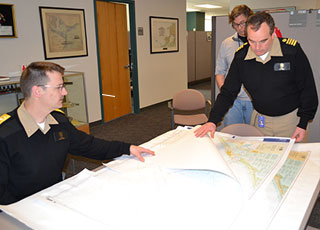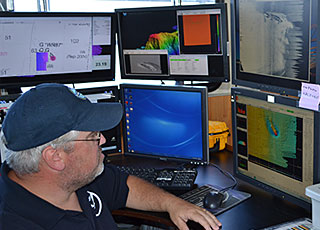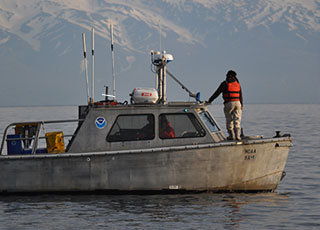
NOAA’s Office of Coast Survey (OCS), which creates and maintains the nation's suite of 1,000 nautical charts of U.S. coastal waters, ceased to print traditional lithographic (paper) nautical charts in FY 14. NOAA will continue to produce other forms of nautical charts, including the increasingly popular POD (Print-on-Demand) charts, which are updated paper charts available from NOAA-certified printers; and the new full-scale PDF (Portable Digital Format) nautical charts, available for free download on a trial basis. NOAA electronic navigational charts (NOAA ENC®) and raster navigational charts (NOAA RNC®), which are used in a variety of electronic charting systems, will continue to be updated weekly and made available for free download from the OCS website.

In FY 14, NOAA’s Office of Coast Survey improved its Wrecks and Obstructions Database, giving the public easy access to nearly 20,000 records of submerged wrecks and other obstructions to navigation within U.S. maritime boundaries. The new service is an upgrade of a wreck database first established in 1981: It now includes all of the wrecks that are mapped on NOAA’s electronic navigational charts, and provides the data in formats that can be used in GIS software programs, Google Maps, and Google Earth. The data includes the position of each feature (latitude and longitude) and, when available, a brief description. While the locations of wrecks and other obstructions have always been important for safe coastal navigation, people interested in shipwrecks for other reasons, such as for marine archeology, recreational diving, salvage operations, and fishing, now have thousands of new records to explore.

NOAA’s Office of Coast Survey (OCS) and NOAA’s Center for Operational Oceanographic Products and Services made two Operational Forecast Systems (OFS) available to the public in FY 14. The San Francisco Bay OFS provides users with nowcasts (analyses of near-present conditions) and forecast guidance out to 48 hours for water levels, currents, water temperature, and salinity. A similar forecast system was implemented for the northern Gulf of Mexico. Additionally, OCS, in collaboration with the National Weather Service’s National Center for Environmental Prediction, implemented the Extratropical Surge and Tide Operational Forecast System for the Pacific (ESTOFS Pacific). This OFS covers the U.S. West Coast, the Gulf of Alaska, and Hawaii. ESTOFS Pacific provides 180-hour forecasts of water levels caused by storm surge, astronomical tides, and the combined effects of storm surge and tides. In addition to providing weather forecasters with guidance on storm surge and tidal water levels, ESTOFS Pacific is also used by NOAA's WAVEWATCH III wave model for coupling wave and water level predictions.

In FY 14, NOAA’s Office of Coast Survey issued a new nautical chart for the Arctic’s Delong Mountain Terminal, a shallow-draft port that services the Red Dog Mine on Alaska’s northwest coast. New Chart 16145, which fills in historically sparse depth measurements using recently acquired survey data, is important to the Arctic economy and will help improve maritime safety and efficiency. Zinc and lead are mined at Red Dog, which is one of the world’s largest producers of zinc concentrate. The terminal’s shipping season lasts only about 100 days, so shipping efficiency is vital. This is the third new Arctic chart that NOAA has issued in as many years, the others being for Kotzebue Harbor in 2012 and Bering Strait North in 2013.

NOAA’s Office of Coast Survey developed an online project called Integrated Ocean and Coastal Mapping Sandy Coordination to foster collaboration on Post-tropical Cyclone Sandy data acquisition in FY 14. The goal was to gather as much information as possible about mapping needs and plans to support decision-making and restoration in Sandy-impacted coastal areas, while eliminating overlaps. The site displays federal and state mapping requirements and plans acquired from external partners. The project is part of SeaSketch, a user-friendly GIS developed by the McClintock Laboratory at the University of California Santa Barbara.
 An official website of the United States government.
Here's how you know we're official.
An official website of the United States government.
Here's how you know we're official.




